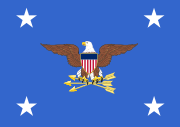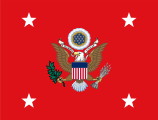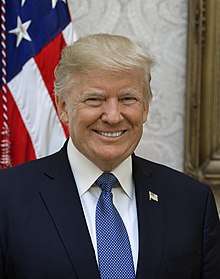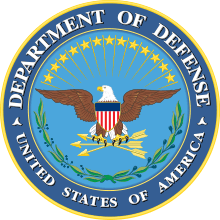Mark Esper
Mark Thomas Esper (born April 26, 1964)[1][2] is the 27th and current United States Secretary of Defense, and a former U.S. Army officer and defense contractor lobbyist. He previously served as the 23rd United States Secretary of the Army from 2017 to 2019.
Mark Esper | |
|---|---|
 | |
| 27th United States Secretary of Defense | |
| Assumed office July 23, 2019 | |
| President | Donald Trump |
| Deputy | Richard V. Spencer (acting) David Norquist |
| Preceded by | Jim Mattis |
| In office Acting: June 24, 2019 – July 15, 2019 | |
| President | Donald Trump |
| Deputy | David Norquist (acting) |
| Preceded by | Patrick M. Shanahan (acting) |
| Succeeded by | Richard V. Spencer (acting) |
| 23rd United States Secretary of the Army | |
| In office November 20, 2017 – July 23, 2019* | |
| President | Donald Trump |
| Deputy | Ryan McCarthy |
| Preceded by | Ryan McCarthy (acting) |
| Succeeded by | Ryan McCarthy |
| Personal details | |
| Born | Mark Thomas Esper April 26, 1964 Uniontown, Pennsylvania, U.S. |
| Political party | Republican |
| Spouse(s) | Leah Lacy (m. 1989) |
| Children | 3 |
| Education | United States Military Academy (BS) Harvard University (MPA) George Washington University (PhD) |
| Civilian awards | |
| Military service | |
| Allegiance | |
| Branch/service | |
| Years of service | 1986–2007 |
| Rank | |
| Unit | 101st Airborne Division Virginia Army National Guard D.C. Army National Guard U.S. Army Reserve |
| Battles/wars | Gulf War |
| Military awards | |
| *McCarthy served in an acting capacity from June 24, 2019 to July 15, 2019, while Esper served as acting secretary of defense. | |
President Donald Trump announced on June 18, 2019, that Esper would become acting secretary of defense, succeeding acting secretary Patrick M. Shanahan.[3] Before Shanahan withdrew his name from consideration for the position, Esper had been considered a leading candidate for the nomination had the Senate declined to confirm Shanahan.[4] Esper assumed the office of acting secretary on June 24, and was confirmed as 27th Secretary of Defense by the United States Senate with a vote of 90–8 on July 23, 2019.[5]
A West Point graduate, Esper began his career with decorated service as a commissioned officer in the United States Army. Later, he served as a Senate staffer, chief of staff at The Heritage Foundation, and Vice President for Government Relations at Raytheon.
Early life and education
Esper was born in Uniontown, Pennsylvania, the son of Pauline "Polly" (Reagan) and Thomas Joseph Esper.[6] His father was a member of the Maronite Church.[7] His paternal grandfather was an immigrant from Lebanon, and his uncle was war journalist George Esper.[8]
Esper graduated from Laurel Highlands High School outside Uniontown, Pennsylvania, in 1982.[9] He received his Bachelor of Science in engineering from the United States Military Academy in 1986. Esper was a dean's list student at West Point and received the Douglas MacArthur Award for Leadership.[10] He received a master's degree in public administration from the John F. Kennedy School of Government at Harvard in 1995 and a doctorate in public policy from George Washington University in 2008.[11]
Esper married his wife, Leah Lacy, in 1989.[2][12] They have three children: Luke, John and Kate.[13][14]
Career
Esper served as an infantry officer with the 101st Airborne Division and deployed with the "Screaming Eagles" for the Gulf War. His battalion was part of the famous "left hook" that led to the defeat of the Iraqi Army.[15] For his actions, Esper was awarded a Bronze Star, the Combat Infantryman's Badge, and various service medals.[10] He later commanded an airborne rifle company in Europe and served as an Army fellow at the Pentagon.[9] Esper served on active duty for more than ten years before moving to the Army National Guard and later the Army Reserve, rising to the rank of lieutenant colonel.[16] Esper is a recipient of the Department of Defense Medal for Distinguished Public Service. Among his military awards and decorations are the Legion of Merit, Bronze Star Medal, Kuwait Liberation Medal, and the Combat Infantryman Badge.[13]
Esper was chief of staff at the Heritage Foundation, a conservative think tank, from 1996 to 1998.[17] From 1998 to 2002, Esper served as a senior professional staffer for the Senate Foreign Relations Committee and the Senate Governmental Affairs Committee. He was also a senior policy advisor and legislative director for U.S. senator Chuck Hagel.[18] He was policy director for the House Armed Services Committee from 2001 to 2002. From 2002 to 2004, Esper served in the George W. Bush administration as deputy assistant secretary of defense for negotiations policy, where he was responsible for a broad range of nonproliferation, arms control, and international security issues. He was director for national security affairs for the U.S. Senate under Senate majority leader Bill Frist from 2004 to 2006.
Esper was executive vice president at the Aerospace Industries Association in 2006 and 2007. From September 2007 to February 2008, Esper served as national policy director to Senator Fred Thompson in his 2008 presidential campaign. From 2008 to 2010, Esper served as executive vice president of the Global Intellectual Property Center and vice president for Europe and Eurasia at the U.S. Chamber of Commerce. He was hired as vice president of government relations at defense contractor Raytheon in July 2010.[18] Esper was recognized as a top corporate lobbyist by The Hill in 2015 and 2016.[19][20] Esper's departure from Raytheon included a deferred compensation package after 2022, based partly on Raytheon's stock price.[21]
Secretary of the Army
President Donald Trump announced his intention to nominate Esper as Secretary of the Army on June 19, 2017.[22] He was Trump's third nominee for the position, following the withdrawals of Vincent Viola and Mark E. Green.[23] He was confirmed to this post by an 89–6 vote of the U.S. Senate on November 15, 2017[24] and sworn in on November 20, 2017.
While serving as Army Secretary, Esper was asked by reporters in 2018 whether soldiers had concerns about serving beside openly transgender individuals. He replied that "It really hasn't come up."[25] After he was nominated to become Secretary of Defense, he said that being transgender is not an issue with him, stating that he has met several transgender servicemembers and was impressed with many of them. He supports Directive-type Memorandum-19-004, claiming it is not a "blanket ban" on transgender military service and said that he believes anyone who can meet the military standards without "special accommodations" and is worldwide deployable should be able to serve, including transgender individuals as long as they can adhere to cisgendered standards associated with their biological sex. He said people in the military with gender dysphoria would have their condition assessed and "in many cases", be offered waivers that would allow them to serve. He cited the United States Department of Defense's 2018 Report and Recommendations on Military Service by Transgender Persons, which claims that persons who have a history of gender dysphoria, who have undergone medical treatments for gender transition, or who are unable or unwilling to meet the military's standards associated with their biological sex, could hurt military readiness and effectiveness and should be evaluated to see whether they should be retained or expelled from service.[26][27]
Secretary of Defense
Temporary appointment and nomination
.jpg)
President Trump announced the appointment of Esper as Acting Secretary of Defense on June 18, 2019, after Acting Secretary Patrick Shanahan decided to withdraw his nomination.[3] Four days later, it was announced that Trump would nominate Esper to serve as Secretary of Defense in a permanent capacity.[28] On July 15, 2019, the White House formally sent his nomination to the Senate.[29][30] Following his formal nomination, Esper was replaced as Acting Defense Secretary by Secretary of the Navy Richard Spencer, as the Federal Vacancies Reform Act of 1998 prevented Esper from serving as acting secretary while his nomination was formally under consideration. During that period, Esper reverted to his position as Secretary of the Army.[31] The Senate Committee on Armed Services scheduled a hearing on the nomination for the next day.[32] On July 22, 2019, the Senate voted 85–6 to invoke cloture on his nomination.[33] On July 23, 2019, his nomination was confirmed by a vote of 90–8.[34]
Tenure

Esper has said that his operating positions as Secretary of Defense would be apolitical, in keeping with the National Defense Strategy formulated in 2018 by his predecessor Jim Mattis.[35]
On November 24, 2019, during a dispute regarding whether Navy SEAL Eddie Gallagher would be stripped of his Trident pin, Esper fired the United States secretary of the Navy, Richard Spencer. The Department of Defense attributed the firing to Spencer privately proposing to the White House (without informing Esper, and contrary to Spencer's public position) an arrangement to let Gallagher retire while keeping his Trident pin. On November 25, Esper stated that Trump had ordered him to stop the Navy from conducting a peer review regarding Gallagher's right to wear the pin. Esper said he previously supported the peer review, but followed Trump's order.[36] Meanwhile, Trump cited the Gallagher case as the primary reason for Esper's firing of Spencer, while also citing "large cost overruns" in the Navy.[37]
Esper met with his European counterparts in February 2020 to discuss basing options for a new United States Army headquarters in Europe, bearing the name "V Corps" that had originally been established in World War I but was inactivated while stationed in Germany in 2013. Esper stated the new headquarters was needed to improve military coordination among NATO partners.[38]
COVID-19 pandemic
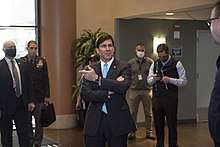
In late January 2020, as the coronavirus spread, Esper said he was "not tracking" its spread, as the Trump administration downplayed the risks of the disease.[39][40]
As the coronavirus outbreak turned into a pandemic in early March 2020, Esper directed overseas commanders of U.S. forces to check with him before taking actions to protect U.S. troops, lest they contradict the Trump administration's messaging on the coronavirus. A Defense Department official said Esper's intent was to ensure that the government was "communicating to the public with one voice on a rapidly developing situation" and Esper assured the public that "My No. 1 priority remains to protect our forces and their families.”[41] The following week, Esper directed the deployment of two Navy hospital ships, the USNS Comfort and the USNS Mercy, to take pressure off New York and Los Angeles hospitals as they coped with the pandemic.[42] Esper also authorized the Defense Department to provide civilian health authorities with five million respirator masks and 2,000 specialized ventilators.[43]
In early April, Acting Secretary of the Navy Thomas Modly removed Navy Captain Brett Crozier from command of the aircraft carrier USS Theodore Roosevelt after Crozier pleaded with Navy leaders to move more quickly to in the face of a coronavirus outbreak on the ship. Esper defended Modly's decision,[44] though he conceded that he had not read Crozier's letter calling for help.[40] Within days, widespread condemnation led Modly to resign. Esper named James McPherson, Under Secretary of the Army, to replace him.[45]
On April 14, 2020, Esper announced the extension of a travel freeze on military members and Department of Defense civilian employees. The original order to stop movement was to last for 60 days, but Esper said that additional time was needed to stop the spread of the virus.[46] Several days following the announcement, Esper extended the freeze through June 30, 2020.[47]
Lawmakers, retired officers and experts criticized Esper's response to the coronavirus, describing it as slow and indecisive. According to Politico, there was discontent within the Department of Defense about Esper's leadership on the issue. Esper primarily left it up to local commanders in terms of how they would respond to the pandemic, which resulted in uneven responses. Several military officials said there was a lack of top-down planning and guidance on important decisions.[40] In a letter in late April 2020, ten Democratic senators called Esper's leadership "disjointed and slow", saying that DOD's civilian leadership had "failed to act sufficiently, quickly, and has often prioritized [combat] readiness at the expense of the health of service members and their families."[48] A Pentagon spokesman defended DoD's handling of the pandemic.[49][50]
In May 2020, at an event marking the 75th anniversary of the Allied victory in Europe, Esper interacted without a face mask with seven World War II veterans who were between the ages of 96 and 100. The elderly are at an elevated risk of illness and death from the coronavirus; health experts and authorities advise that the spread can be halted with face masks and social distancing measures. In response to critics, Jonathan Hoffman, a Pentagon spokesman, said Esper was tested before the event; a White House official said the veterans were also tested before the event.[51]
That same month, Esper declared that a widely available vaccine would be available by the end of 2020. However, a leaked Pentagon memo said there was a "real possibility" that a vaccine would not be available until "at least the summer of 2021."[52][53]
George Floyd protests
| Wikisource has original text related to this article: |
On June 1, 2020, amid nationwide civil unrest arising from the killing of George Floyd by police, Secretary Esper was called to the White House to meet with President Trump. In a heated and contentious debate in the Oval Office President Trump demanded the military put 10,000 active duty troops into the streets immediately, a senior administration official told CBS News. Attorney General William Barr, Defense Secretary Mark Esper and Joint Chiefs Chairman Mark Milley objected to the demand, the official said. Later that morning, in an attempt to satisfy Mr. Trump's demand, Esper and Milley used a call with the nation's governors to implore them to call up the National Guard in their own states, the official said. If these governors didn't "call up the Guard, we'd have (active duty) troops all over the country," this official said.[54]
The call with the governors was focused on the need to deal with those breaking the law and committing acts of violence against the police, their fellow citizens, and private property. During the call, President Trump, Attorney General Barr, and Secretary Esper spoke of “dominating” the streets as a way to reduce violence and allow peaceful protestors to exercise their First Amendment rights. Attorney General Barr spoke of calling up additional law enforcement assets. Secretary Esper spoke of governors' employing the National Guard under their (state) control, citing the action taken and positive results achieved by Governor Tim Walz, Democrat of Minnesota, over the previous weekend. [55]
During the call Secretary Esper told state governors, "I think the sooner that you mass and dominate the battlespace, the quicker this dissipates and we can get back to the right normal."[56]
In a June 3rd Pentagon press conference two days later, in response to reporter's question, Secretary Esper clarified details of the call with the governors:
"Secretary Esper press conference on civil unrest - YouTube". www.youtube.com. Retrieved June 26, 2020.
With regard to your first question, as you rightly said earlier this week, I was quoted as saying, 'The best way to get street violence under control was by dominating the battle space.'"
"And probably all of you who covered the Pentagon, hear us use this phrase often. It’s something we use day in and day out. There are other phrases that we use day in day out that you’ll understand that most people don’t understand. It is part of our military lexicon that I grew up with, and it’s what we routinely use to describe a bounded area of operations. It’s not a phrase focused on people, and certainly not on our fellow Americans as some have suggested. It is a phrase I used over the weekend when speaking with Minnesota Governor Walz. He and I spoke a couple of times on Friday and Saturday, as I spoke to him about DOD support to what was happening there. Keep in mind, it was only a few short days ago where Minneapolis was the epicenter and all eyes were focused on Minnesota. But Governor Walz was also a former member of the National Guard, and I was complimenting him on the call with the governors about what he had done."
"It was his (Minnesota Governor Tim Walz) successful use of the Guard in sufficient numbers that really rested control of the streets from the looters and others breaking the law, so I was giving him credit for that. And he was doing so, so the peaceful demonstrations could be held, so that peaceful demonstrators could share their frustration and their anger. That’s what I was encouraging other governors to consider. In retrospect, I would use different wording. So as to not distract from the more important matters at hand, or allow some to suggest that we are militarizing the issue."[57]
In a June 2nd memorandum to all Department of Defense personnel[58] – less than 24 hours after civil unrest arising from the killing of George Floyd by police – Secretary Esper reminded service members and DOD civilians about their sworn oath to defend the Constitution of the United States, and the importance of that oath to all Americans in guaranteeing their rights:
"As part of that oath, we commit to protecting the American people's right to freedom of speech and to peaceful assembly. I, like you, am steadfast in my belief that Americans who are frustrated, angry, and seeking to be heard must be ensured that opportunity. And like you, I am committed to upholding the rule of law and protecting life and liberty, so that the violent actions of a few do not undermine the rights and freedoms of law-abiding citizens."
On June 1st, amid nationwide civil unrest arising from the killing of George Floyd by police, Secretary Esper walked alongside Trump to a photo op in front of St. John's Episcopal Church outside the White House; just prior, police in riot gear and mounted police cleared protestors who had been throwing bricks and other projectiles[59] from Lafayette Square, using smoke and flash grenades and a chemical irritant spray, clearing a path for President Trump, Secretary Esper and several other Trump administration officials.[60] Secretary Esper's participation in the photo op was criticized by a number of retired senior military officers.[61] Two days later, June 3rd, in his prepared remarks given at a Pentagon Press Conference, Secretary Esper commented on this matter after an NBC report had misquoted him:[62]
"Last night, a story came out based on a background interview I did earlier in the day, it focused on the events of last Monday evening in Lafayette Park, and I found it to be inaccurate in parts. So I want to state very clearly for all to hear my account of what happened that Monday afternoon.
I did know that following the president’s remarks on Monday evening, that many of us were going to join President Trump and review the damage in Lafayette Park and at St. John’s Episcopal Church. What I was not aware of was exactly where we’re going when we arrived at the church and what the plans were once we got there.
It was also my aim and General Milley’s to meet with and thank the members of the National Guard who were on duty that evening in the park. It is something the president likes to do as well. The path we took to and from the church didn’t afford us that opportunity, but I was able to spend a considerable amount of time with our Guardsman later that evening, as I moved around the city to many of the locations at which they were posted."
At the same June 3rd Pentagon press conference, in responding to reporter's question, Secretary Esper further clarified:[57]
"Well, I did know that we were going to the church. I was not aware of a photo op was happening. Of course, the president drags a large press pool along with him. And look, I do everything I can to try to stay apolitical and try and stay out of situations that may appear political. And sometimes I’m successful at doing that, and sometimes I’m not as successful, but my aim is to keep the department out of politics to stay apolitical. And that’s what I continue to try and do as well as my leaders, here in the department."
In a June 2nd memorandum to all Department of Defense personnel[58] Secretary Esper made clear the importance of the US military remaining apolitical:
"As I reminded you in February, I ask that you remember at all times our commitment as a Department and as public servants to stay apolitical in these turbulent days. For well over two centuries, the U.S. military has earned the respect of the American people by being there to protect and serve all Americans."
Additionally, in the above-cited Pentagon press briefing, less than 36 hours after the events of the previous Monday evening, Secretary Esper broke with President Trump by announcing that active-duty troops should not be used in American cities, called up under invocation of the 1807 Insurrection Act[63] Secretary Esper’s act of defiance was an assertion of the military’s proper role in society, and the importance of the Defense Department remaining apolitical, a defender of Constitutional rights for all Americans.
"I’ve always believed and continue to believe that the National Guard is best suited for performing domestic support to civil authorities and these situations in support of local law enforcement. I say this not only as Secretary of Defense, but also as a former soldier, and a former member of the National Guard. The option to use active duty forces in a law enforcement role should only be used as a matter of last resort, and only in the most urgent and dire of situations. We are not in one of those situations now. I do not support invoking the Insurrection Act."[63]
Secretary Esper’s statement damped President Trump's push to invoke the Insurrection Act and changed the dynamic of the first two days. Secretary Esper took steps in the following days to further de-escalate the situation, removing weapons and ammunition from the National Guard, and returning troops to their home bases without notifying the White House. The President was already furious about Esper’s unwillingness to employ active duty troops, and came close to firing him. [64]
On June 6th, the House Armed Services Committee invited Secretary Esper and Chairman of the Joint Chiefs of Staff Milley to testify before the committee regarding the events of June 1st. Amidst claims that Secretary Esper and Joint Chiefs Chariman Milley "refused" to testify, the Pentagon pushed back on the characterization. Chief spokesman Jonathan Hoffman said in statement that the pair "have not 'refused' to testify" and that the department's “legislative affairs team remains in discussion" with the committee.[65] In the meantime, on June 8th, DoD provided Army Secretary Ryan McCarthy to brief the committee on the presence of the National Guard in Washington, D.C., this past week.” [66]
References
- Zajac, Frances Borsodi (August 17, 2017). "Trump nominating Uniontown native for Army secretary | Local News". The Herald-Standard. Retrieved December 18, 2017 – via heraldstandard.com.
- "Secretary of the Army: Who Is Mark Esper?". AllGov.
- @realDonaldTrump (June 18, 2019). "....I thank Pat for his outstanding service and will be naming Secretary of the Army, Mark Esper, to be the new Acting Secretary of Defense. I know Mark, and have no doubt he will do a fantastic job!" (Tweet) – via Twitter.
- "Shanahan withdraws from consideration to be U.S. defense secretary". Reuters. June 18, 2019. Retrieved June 18, 2019.
- Youssef, Nancy A. (July 23, 2019). "Mark Esper Sworn In as Defense Secretary". Wall Street Journal. Retrieved July 25, 2019.
- Zajac, Frances Borsodi (March 8, 2018). "Uniontown native serves country as Secretary of the Army". The Herald-Standard.
- "Thomas Joseph Esper". The Herald-Standard. December 5, 2014.
- "Pentagon and Hanoi defense chiefs trade artifacts of soldiers missing from Vietnam War". Washington Examiner. November 22, 2019.
- Basinger, Rachel (August 31, 2013). "Laurel Highlands to honor Hall of Fame inductees". TribLIVE.
- Ekas, Cindy (September 7, 2017). "Laurel Highlands lauds alumni's achievements". Pittsburgh Tribune-Review. Trib Total Media. Retrieved September 25, 2017 – via Trib LIVE (triblive.com).
- Hubler, David (July 16, 2010). "Raytheon adds defense expert to lead government relations unit". Washington Technology.
- "Mark Esper, Secretary of Defense". Presidential Prayer Team. April 23, 2020. Retrieved June 18, 2020.
- Defense.gov (July 23, 2019) Dr. Mark T. Esper: Secretary of Defense Department of Defense biography
- "Mark Esper". The Hill. Retrieved June 18, 2020.
- Eric Milzarski (Nov. 17, 2017) This is what you need to know about Mark Esper, the new Army Secretary: Served in 3-187th Infantry battalion.
- Shane III, Leo (July 19, 2017). "Trump to nominate Raytheon VP, Gulf War vet as next Army secretary". Military Times.
- "U.S. Chamber Bolsters Its Europe-Eurasia Team". U.S. Chamber of Commerce. November 20, 2008.
- "Raytheon Names Mark T. Esper Vice President of Government Relations". Raytheon: Investors: Investor Relations. Raytheon. July 16, 2010. Retrieved September 25, 2017 – via investor.raytheon.com.
- Dickson, Rebecca (October 29, 2015). "Top Lobbyists 2015: Corporate". The Hill.
- Dickson, Rebecca (October 26, 2016). "Top Lobbyists 2016: Corporate". The Hill.
- Bort, Ryan; Bort, Ryan (July 17, 2019). "Trump's Pick for Defense Secretary Is as Swampy as You'd Expect". Rolling Stone. Retrieved January 18, 2020.
- McIntyre, Jamie (July 19, 2017). "Exclusive: Trump to nominate Mark Esper as Army secretary". Washington Examiner.
- Gibbons-Neff, Thomas; Jaffe, Greg (July 19, 2017). "Trump to nominate Raytheon lobbyist for next Army secretary". Washington Post.
- "PN811 – Mark T. Esper – Department of Defense". U.S. Congress. November 15, 2017. Retrieved November 16, 2017.
- Mclaughlin, Elizabeth. "Soldiers not asking about transgender policy: Army secretary". ABC News.
- "CNN'S Amanpour Transcripts". edition.cnn.com. June 6, 2019. Retrieved August 23, 2019.
- "Senate Armed Services Committee Advance Policy Questions for Dr. Mark T.Esper Nominee for Appointment to be Secretary of Defense" (PDF).
- Cooper, Helene (June 21, 2019). "Trump Nominates Mark Esper as Next Defense Secretary". The New York Times. Retrieved June 22, 2019.
- "One Nomination Sent to the Senate". The White House.
- "PN934 — Mark T. Esper — Department of Defense". U.S. Congress. July 15, 2019. Retrieved July 16, 2019.
- Jim Garamone (July 15, 2019). "Esper nominated as Defense Secretary, Spencer now Acting Secretary". United States Department of Defense. Retrieved July 24, 2019.
- "Nomination -- Esper". U.S. Senate Committee on Armed Services. Retrieved July 16, 2019.
- "U.S. Senate: U.S. Senate Roll Call Votes 116th Congress - 1st Session". senate.gov.
- "U.S. Senate: U.S. Senate Roll Call Votes 116th Congress - 1st Session". senate.gov.
- Ryan, Missy; Lamothe, Dan (August 6, 2019). "Defense secretary Mark Esper wants to deliver on the goal of outpacing China". The Washington Post. Retrieved August 23, 2019.
- Burns, Robert. "Esper says Trump ordered him to stop SEAL review board". Associated Press. Retrieved November 26, 2019.
- McLaughlin, Elizabeth; Martinez, Luis. "Pentagon chief Mark Esper fires Navy Secretary Richard Spencer over handling of Navy SEAL case". ABC News. Retrieved November 25, 2019.
- Youssef, Nancy A. (February 12, 2020). "Army Sets Up Base to Coordinate With Europe" (Page A6). The Wall Street Journal. Retrieved February 15, 2020.
- "Inside The Pentagon's Lurching Efforts To Protect Its People from the Coronavirus". Defense One. Retrieved June 2, 2020.
- "'Lack of leadership': Esper's pandemic response draws fire as crisis deepens". POLITICO. Retrieved June 2, 2020.
- Schmitt, Eric; Cooper, Helene (March 2, 2020). "Defense Secretary Warns Commanders Not to Surprise Trump on Coronavirus". The New York Times. ISSN 0362-4331. Retrieved March 15, 2020.
- Burgess, Richard R. (March 18, 2020). "Esper Orders Navy to Ready Hospital Ships to Take Pressure Off U.S. Hospitals". Seapower. Retrieved March 19, 2020.
- Burns, Robert (March 17, 2020). "Esper: Pentagon to give respirator masks, ventilators to HHS". Associated Press. Retrieved March 19, 2020.
- Cole, Devan. "Esper defends removing USS Theodore Roosevelt commander who sounded alarm over coronavirus". CNN. Retrieved April 15, 2020.
- Martinez, Luis. "Acting Navy secretary resigns after carrier remarks, Esper names replacement". ABC News. Retrieved April 15, 2020.
- Mitchell, Ellen. "Pentagon to extend troop movement freeze past May 11". The Hill. Retrieved April 15, 2020.
- Crawford, Jamie. "Esper to extend travel restrictions for Defense Department personnel". CNN. Retrieved April 29, 2020.
- "Senate Democrats rip Pentagon's coronavirus response in letter to Esper". Stars and Stripes. Retrieved June 2, 2020.
- Kheel, Rebecca. "Senate Democrats pan Esper for 'failed' coronavirus response". The Hill. Retrieved April 29, 2020.
- Williams, Katie Bo. "Pentagon's Esper Was Too Slow With Coronavirus Response, Senate Democrats Say". Defense One. Retrieved April 29, 2020.
- "Defense Secretary Esper stood beside World War II veterans — without a mask". The Washington Post. 2020.
- Britzky, Haley. "Leaked Pentagon memo warns of 'real possibility' of COVID-19 resurgence, vaccine not coming until summer 2021". Task & Purpose. Retrieved June 2, 2020.
- Myers, Meghann (May 19, 2020). "Pentagon memo contradicts Esper's year-end coronavirus vaccine goal, per report". Military Times. Retrieved June 2, 2020.
- Martin, David. "Trump demanded 10,000 active-duty troops deploy to streets in heated Oval Office meeting". www.cbsnews.com. Retrieved June 26, 2020.
- "READ: President Trump's call with US governors over protests". CNN. Retrieved June 26, 2020.
- "READ: President Trump's call with US governors over protests". CNN. Retrieved June 26, 2020.
- "Secretary of Defense Mark Esper Press Conference Transcript: Does Not Support Military Response to Protests". Rev. Retrieved June 26, 2020.
- "Message to the Department on support to civil authorities" (PDF). Media.defense.gov. June 3, 2020.
- Gelles, Karl. "How police pushed aside protesters ahead of Trump's controversial church photo". Retrieved June 10, 2020.
- Baker, Peter; Haberman, Maggie; Rogers, Katie; Kanno-Youngs, Zolan; Benner, Katie; Willis, Haley; Triebert, Christiaan; Botti, David (June 2, 2020). "How Trump's Idea for a Photo Op Led to Havoc in a Park". The New York Times. ISSN 0362-4331. Retrieved June 4, 2020.
- Stephen Collinson, Military leaders condemn Trump over protest response, CNN (June 4, 2020).
- "Secretary of Defense Mark Esper Press Conference Transcript: Does Not Support Military Response to Protests". Rev. Retrieved June 26, 2020.
- Schmitt, Eric; Cooper, Helene; Gibbons-Neff, Thomas; Haberman, Maggie (June 3, 2020). "Esper Breaks With Trump on Using Troops Against Protesters". The New York Times. ISSN 0362-4331. Retrieved June 26, 2020.
- Sonne, Paul; Nirappil, Paul Sonne National security reporter focusing on the U. S. military; government, Fenit Nirappil Reporter covering D. C.; House, politics Josh Dawsey Reporter covering the White House. "Pentagon disarms National Guard activated in D.C., sends active-duty forces home". Washington Post. Retrieved June 26, 2020.
- Mehta, Aaron (June 8, 2020). "House Armed Services Committee, Pentagon clash over Esper and Milley testimony". Defense News. Retrieved June 26, 2020.
- Kheel, Rebecca (June 8, 2020). "Army briefs House panel on response to DC protests". TheHill. Retrieved June 26, 2020.
External links
| Wikimedia Commons has media related to Mark Esper. |
- "Dr. Mark T. Esper > U.S. DEPARTMENT OF DEFENSE > Biography". U.S. Department of Defense. Retrieved November 5, 2019 – via defense.gov.
- Appearances on C-SPAN
| Political offices | ||
|---|---|---|
| Preceded by Ryan McCarthy Acting |
United States Secretary of the Army 2017–2019 |
Succeeded by Ryan McCarthy |
| Preceded by Patrick M. Shanahan Acting |
United States Secretary of Defense Acting 2019 |
Succeeded by Richard V. Spencer Acting |
| Preceded by Jim Mattis |
United States Secretary of Defense 2019–present |
Incumbent |
| U.S. order of precedence (ceremonial) | ||
| Preceded by Steve Mnuchin as Secretary of the Treasury |
Order of Precedence of the United States as Secretary of Defense |
Succeeded by William Barr as Attorney General |
| U.S. presidential line of succession | ||
| Preceded by Steve Mnuchin as Secretary of the Treasury |
6th in line as Secretary of Defense |
Succeeded by William Barr as Attorney General |
